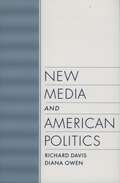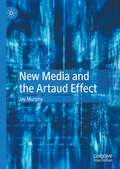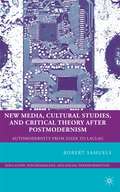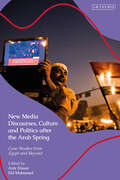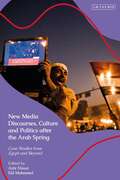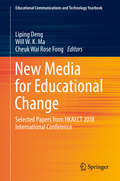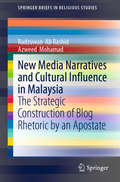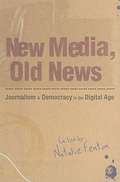- Table View
- List View
New Media: The Key Concepts (The Key Concepts)
by Nicholas Gane David BeerDigital media are rapidly changing the world in which we live. Global communications, mobile interfaces and Internet cultures are re-configuring our everyday lives and experiences. To understand these changes, a new theoretical imagination is needed, one that is informed by a conceptual vocabulary that is able to cope with the daunting complexity of the world today. This book draws on writings by leading social and cultural theorists to assemble this vocabulary. It addresses six key concepts that are pivotal for understanding the impact of new media on contemporary society and culture: information, network, interface, interactivity, archive and simulation. Each concept is considered through a range of concrete examples to illustrate how they might be developed and used as research tools. An inter-disciplinary approach is taken that spans a number of fields, including sociology, cultural studies, media studies and computer science.
New Media and American Politics
by Richard Davis Diana OwenNew Media and American Politics is the first book to examine the effect on modern politics of the new media, which include talk radio, tabloid journalism, television talk shows, entertainment media, and computer networks. Davis and Owen discuss the new media's cultural environment, audience, and content, before going on to evaluate its impact on everything from elections to policy making to the old media itself.
New Media and China's Social Development (Research Series on the Chinese Dream and China’s Development Path)
by Yungeng XieStarting from a history of new media, this book presents the development of network technology and media applications in China, while also examining the relationship between new media and politics, economy, culture, lifestyle, traditional media, law, knowledge, etc. As of 2014, China had been connected to the Internet for 20 years. During those two decades, China has witnessed drastic changes, from its national makeup to people’s daily lives. The book analyzes the changes in China brought about by the new media on the basis of large-scale data. Further, through comparisons with international trends in new media development, it seeks to clarify the new media development in China and comprehensively demonstrate the revolution and brand-new faces of Chinese society over the past two decades in the wake of new media. As such, it outlines the bright future of new media by revisiting and summarizing the developmental courses of new media and Chinese society.
New Media and Chinese Society (Communication, Culture and Change in Asia #5)
by Ke Xue Mingyang YuThis book focuses on the influence of social media on Chinese society. The respective chapters present research by top-tier communication scholars from prominent Chinese universities and offer revealing findings on the interplay between media / social media, economics and politics. To that end, both qualitative and quantitative methods based on classical theories of communication and economics are drawn upon. The book explores four main areas: the challenges and opportunities for Chinese journalism and communications, changes in Chinese economic development, influences and forecasts for Chinese politics, and the impacts on Chinese culture. As the chapter contributors hail from diverse regions within China and represent three generations of communication scholars, the book offers a comprehensive guide, helping readers understand the impact of social media on China’s development from a broad range of perspectives, and sharing insights on its impacts around the world.
New Media and Public Diplomacy: Political Communication in India, the United States and China
by Parama Sinha PalitThis book examines the role of new media and digital technologies in public diplomacy and political communication. Exploring political communication in India as well as in the US and China, it highlights the fundamental changes that new technology has brought about in public diplomacy. While facilitating direct engagement with constituents and tapping into territories and audiences which were harder to reach before, the new media’s power to influence perceptions has revolutionised public diplomacy and engagement like never before. While managing national brands utilizing digital tools has emerged imperative for contemporary nation states, they are equally engaged in online disinformation and influence campaigns. This book analyzes these activities and also emphasizes the critical role of social media in defining and shaping political attitudes while empowering the ordinary public and the leadership alike. The author, through examples from India, the US, and China, also examines the challenges of using digital tools in diplomacy and its effects on democracies across the world. Lucid and engaging, this book will be an essential read for students and scholars of communication studies, political studies, diplomacy and foreign policy, defence and strategic analysis, media and culture studies, and international relations.
New Media and Public Diplomacy: Political Communication in India, the United States and China
by Parama Sinha PalitThis book examines the role of new media and digital technologies in public diplomacy and political communication. Exploring political communication in India as well as in the US and China, it highlights the fundamental changes that new technology has brought about in public diplomacy. While facilitating direct engagement with constituents and tapping into territories and audiences which were harder to reach before, the new media’s power to influence perceptions has revolutionised public diplomacy and engagement like never before. While managing national brands utilizing digital tools has emerged imperative for contemporary nation states, they are equally engaged in online disinformation and influence campaigns. This book analyzes these activities and also emphasizes the critical role of social media in defining and shaping political attitudes while empowering the ordinary public and the leadership alike. The author, through examples from India, the US, and China, also examines the challenges of using digital tools in diplomacy and its effects on democracies across the world. Lucid and engaging, this book will be an essential read for students and scholars of communication studies, political studies, diplomacy and foreign policy, defence and strategic analysis, media and culture studies, and international relations.
New Media and the Artaud Effect
by Jay MurphyThis book proposes, following Antonin Artaud, an investigation exploring the virtual body, neurology and the brain as fields of contestation, seeking a clearer understanding of Artaud's transformations that ultimately leads into examining the relevance Artaud may have for an adequate theory of the current media environment.New Media and the Artaud Effect is the only current full-length study of the relation of Artaud’s work to dilemmas of digital art, media and society today. It is also singular in that it combines a far-reaching discussion of the theoretical implications and ramifications of the ‘late’ or ‘final’ Artaud, with a treatment of individual media works, sometimes directly inspired from Artaud’s travails.Artaud has long been justly regarded as one of the seminal influences in mid- and late-20th century performance and theater: it is argued here that Artaud’s insights are if anything more applicable to digital/post-digital society and the plethora of works that are made possible by it.
New Media and the New Middle East (The Palgrave Macmillan Series in International Political Communication)
by Philip SeibIn this book, leading international scholars examine the way new media is reshaping lives and politics. Covering topics from women's rights to terrorism, and countries from Israel to Saudi Arabia, these authors explore the global and regional ramifications of the proliferation of communication technologies and the information they disseminate.
New Media, Cultural Studies, and Critical Theory after Postmodernism: Automodernity from Zizek to Laclau (Education, Psychoanalysis, and Social Transformation)
by R. SamuelsThis book argues that we have moved into a new cultural period, automodernity, which represents a social, psychological, and technological reaction to postmodernity. In fact, by showing how individual autonomy is now being generated through technological and cultural automation, Samuels posits that we must rethink modernity and postmodernity.
New Media Discourses, Culture and Politics after the Arab Spring: Case Studies from Egypt and Beyond
by Aziz Douai and Eid MohamedThis book investigates the interplay between media, politics, religion, and culture in shaping Arabs' quest for more stable and democratic governance models in the aftermath of the “Arab Spring” uprisings. It focuses on online mediated public debates, specifically user comments on online Arab news sites, and their potential to re-engage citizens in politics. Contributors systematically explore and critique these online communities and spaces in the context of the Arab uprisings, with case studies, largely centered on Egypt, covering micro-bloggers, Islamic discourse online, Libyan nationalism on Facebook, and a computational assessment of online engagement, among other topics.
New Media Discourses, Culture and Politics after the Arab Spring: Case Studies from Egypt and Beyond
This book investigates the interplay between media, politics, religion, and culture in shaping Arabs' quest for more stable and democratic governance models in the aftermath of the “Arab Spring” uprisings. It focuses on online mediated public debates, specifically user comments on online Arab news sites, and their potential to re-engage citizens in politics. Contributors systematically explore and critique these online communities and spaces in the context of the Arab uprisings, with case studies, largely centered on Egypt, covering micro-bloggers, Islamic discourse online, Libyan nationalism on Facebook, and a computational assessment of online engagement, among other topics.
New Media for Educational Change: Selected Papers from HKAECT 2018 International Conference (Educational Communications and Technology Yearbook)
by Liping Deng Will W. Ma Cheuk Wai FongThis book gathers selected papers presented at the Hong Kong Association for Educational Communications and Technology 2018 International Conference on the theme of “new media for educational change: effects on learning and reflection on practice”. It contributes to a scholarly discussion that goes beyond what new media can contribute to education, and reflects on best practices as well as lessons learned by applying new media in a wide range of fields. Scholars from educational technology, journalism, higher education, etc. share their findings in a number of formats, such as empirical research, case studies of best practices, literature reviews, etc. The topics addressed include but are not limited to media practice, application of innovative technologies, MOOCs in higher education, social media for learning, gamification, learning analytics, and comparative studies.
New Media in Black Women’s Autobiography: Intrepid Embodiment and Narrative Innovation
by T. CurtisExamining novelists, bloggers, and other creators of new media, this study focuses on autobiography by American black women since 1980, including Audre Lorde, Jill Nelson, and Janet Jackson. As Curtis argues, these women used embodiment as a strategy of drawing the audience into visceral identification with them and thus forestalling stereotypes.
New Media Literacies and Participatory Popular Culture Across Borders
by Bronwyn T Williams Amy A ZengerHow do students’ online literacy practices intersect with online popular culture? In this book scholars from a range of countries including Australia, Lebanon, Nepal, Qatar, South Africa, Turkey, and the United States illustrate and analyze how literacy practices that are mediated through and influenced by popular culture create both opportunities and tensions for secondary and university students. The authors examine issues of theory, identity, and pedagogy as they address participatory popular culture sites such as fan forums, video, blogs, social networking sites, anime, memes, and comics and graphic novels. Uniquely bringing together scholarship about online literacy practices and the growing body of work on participatory popular culture, New Media Literacies and Participatory Popular Culture across Borders makes distinctive contributions to an emerging field of study, pushing forward scholarship about literacy and identity in cross-cultural situations and advancing important conversations about issues of global flows and local responses to popular culture.
New Media Literacies and Participatory Popular Culture Across Borders
by Bronwyn Williams Amy A. ZengerHow do students’ online literacy practices intersect with online popular culture? In this book scholars from a range of countries including Australia, Lebanon, Nepal, Qatar, South Africa, Turkey, and the United States illustrate and analyze how literacy practices that are mediated through and influenced by popular culture create both opportunities and tensions for secondary and university students. The authors examine issues of theory, identity, and pedagogy as they address participatory popular culture sites such as fan forums, video, blogs, social networking sites, anime, memes, and comics and graphic novels. Uniquely bringing together scholarship about online literacy practices and the growing body of work on participatory popular culture, New Media Literacies and Participatory Popular Culture across Borders makes distinctive contributions to an emerging field of study, pushing forward scholarship about literacy and identity in cross-cultural situations and advancing important conversations about issues of global flows and local responses to popular culture.
New Media Narratives and Cultural Influence in Malaysia: The Strategic Construction of Blog Rhetoric by an Apostate (SpringerBriefs in Religious Studies)
by Azweed Mohamad Radzuwan Ab RashidThis book in religious studies uses a Malaysian apostasy case study as a platform to investigate and discuss the broader radicalisation of apostates on social networking sites. It provides new insights into the emerging phenomenon of how social media tools are harnessed to promote faith and beliefs systems, specifically looking at the Malay view of apostasy from Islam. Employing sociocultural theory and theoretical concepts to analyse the discursive behaviour of a Malaysian apostate on a social networking site, the study unpacks how digital storytelling and rhetorical strategies can influence readers, culturally and socially, and contribute to identity construction in relation to politicised viewpoints. The analysis of the discourse surrounding apostasy in Malaysia enables parallels to be drawn to such discourses in other parts of the world, raising discussions on the connections between inflammatory online rhetoric and social problems, such as recruitment to terrorism, involvement in gangs or the use of addictive substances. This book is of particular interest to scholars and students considering the intersection of critical discourse analysis and religious studies. It is of interest to sociolinguists and psychologists interested in online media.
The New Media Nation: Indigenous Peoples and Global Communication (Anthropology of Media #2)
by Valerie AliaAround the planet, Indigenous people are using old and new technologies to amplify their voices and broadcast information to a global audience. This is the first portrait of a powerful international movement that looks both inward and outward, helping to preserve ancient languages and cultures while communicating across cultural, political, and geographical boundaries. Based on more than twenty years of research, observation, and work experience in Indigenous journalism, film, music, and visual art, this volume includes specialized studies of Inuit in the circumpolar north, and First Nations peoples in the Yukon and southern Canada and the United States.
New Media, Old News: Journalism and Democracy in the Digital Age
by Dr Natalie FentonHave new communications technologies revitalised the public sphere, or become the commercial tool for an increasingly un-public, undemocratic news media? Are changing journalistic practices damaging the nature of news, or are new media allowing journalists to do more journalism and to engage the public more effectively? With massive changes in the media environment and its technologies, interrogating the nature of news journalism is one of the most urgent tasks we face in defining the public interest today. The implications are serious, not just for the future of the news, but also for the practice of democracy. In a thorough empirical investigation of journalistic practices in different news contexts, New Media, Old News explores how technological, economic and social changes have reconfigured news journalism, and the consequences of these transformations for a vibrant democracy in our digital age. The result is a piercing examination of why understanding news journalism matters now more than ever. It is essential reading for students and scholars of journalism and new media.
New Media, Old News: journalism & Democracy In The Digital Age (PDF)
by Natalie FentonHave new communications technologies revitalised the public sphere, or become the commercial tool for an increasingly un-public, undemocratic news media? Are changing journalistic practices damaging the nature of news, or are new media allowing journalists to do more journalism and to engage the public more effectively? With massive changes in the media environment and its technologies, interrogating the nature of news journalism is one of the most urgent tasks we face in defining the public interest today. The implications are serious, not just for the future of the news, but also for the practice of democracy. In a thorough empirical investigation of journalistic practices in different news contexts, New Media, Old News explores how technological, economic and social changes have reconfigured news journalism, and the consequences of these transformations for a vibrant democracy in our digital age. The result is a piercing examination of why understanding news journalism matters now more than ever. It is essential reading for students and scholars of journalism and new media.
New Media Spectacles and Multimodal Creativity in a Globalised Asia: Art, Design and Activism in the Digital Humanities Landscape (Digital Culture and Humanities #3)
by Sunny Sui-kwong LamThis edited volume aims to unpack the digitisation of art and media within the dynamics of participatory culture, and how these changes affect the power relations between the production and consumption of these new forms in a globalised Asia. This follows the rise of new art forms and social media platforms in wake of rapid and ongoing digitisation, which has, in turn, produced far-reaching implications for changing media ownership and its role in social, cultural, economic, as well as political activities. New challenges arise every day in relation to digital art and design practices and social media communications, and their respective impact on identity politics. This book showcases a diverse range of interdisciplinary research on these concomitant changes and challenges associated with digital media and technologies within the context of a globalised Asia. The case studies included present perspectives on Asia’s evolving digital humanities landscape from Hong Kong, China, India, Korea and from across Southeast Asia, with topics that tackle organisational digital marketing, brand advertising and design, mobile gaming, interactive art, and the cultural activities of ethnic and sexual minority communities in the region. This book will of interest to scholars in digital humanities focused on new media and cultural studies.
New Media Unions: Organizing Digital Journalists (Disruptions)
by Nicole S. Cohen Greig de PeuterInvestigating the wave of unionization that has seen over 60 digital and legacy media outlets unionize since 2015, this book explores how a flash of organizing by digital-first journalists has become a full-blown movement to unionize journalism, particularly in the United States. Through in-depth interviews with journalists and organizers, New Media Unions maps the process of labor organizing, foregrounding journalists’ voices and documenting a historic and ongoing moment in the digital media industry. Cohen and de Peuter examine what motivates union drives, then follow journalists through the making of a union from scratch. They explore how journalists strategically self-organize, apply their communication skills to alternative ends, generate affective bonds of solidarity, and build power to confront anti-union campaigns and bargain first contracts, winning significant gains and drafting a new labor code for journalism in a digital age. This book demonstrates that if journalism is to have a future, it must be organized. New Media Unions provides a counter-perspective on an industry in flux, whose protagonists—young journalists facing precarious futures—are using collective organizing to articulate a bottom-up vision for journalism’s future. This is a valuable resource for academics and researchers interested in political economy, journalism studies, and labor studies. Book website: www.newmediaunions.com
New Media Unions: Organizing Digital Journalists (Disruptions)
by Nicole S. Cohen Greig de PeuterInvestigating the wave of unionization that has seen over 60 digital and legacy media outlets unionize since 2015, this book explores how a flash of organizing by digital-first journalists has become a full-blown movement to unionize journalism, particularly in the United States. Through in-depth interviews with journalists and organizers, New Media Unions maps the process of labor organizing, foregrounding journalists’ voices and documenting a historic and ongoing moment in the digital media industry. Cohen and de Peuter examine what motivates union drives, then follow journalists through the making of a union from scratch. They explore how journalists strategically self-organize, apply their communication skills to alternative ends, generate affective bonds of solidarity, and build power to confront anti-union campaigns and bargain first contracts, winning significant gains and drafting a new labor code for journalism in a digital age. This book demonstrates that if journalism is to have a future, it must be organized. New Media Unions provides a counter-perspective on an industry in flux, whose protagonists—young journalists facing precarious futures—are using collective organizing to articulate a bottom-up vision for journalism’s future. This is a valuable resource for academics and researchers interested in political economy, journalism studies, and labor studies. Book website: www.newmediaunions.com
New Media Users in China I: A Nodes Perspective (China Perspectives)
by Peng LanAs the first volume of a two-volume set on new media users in China, this book approaches the subject from a macro level by regarding users as constructive nodes within networks, thereby giving insights into the interaction between users and new media and among individuals within the ambit of new media. The author revisits the roles of the typical new media user that has changed from that of a passive "audience member" to a basic unit of the network itself, acting as both a node in the communication network, social network, and service network and also a link between the three. In viewing users as nodes functioning in communication networks and social networks, this volume unravels the new landscapes of communication of the new media era and the consequent profound changes in social relationships, interpersonal connection modes and different methods of interaction. In terms of their role in service networks resting upon the network economy, new media users not only are consumers with personalized needs, but also serve as service guides, resource contributors, and even major productive forces. This title will be a must-read for scholars, students and media professionals interested in the topics of internet communication, new media usage, and media and society as a whole.
New Media Users in China I: A Nodes Perspective (China Perspectives)
by Peng LanAs the first volume of a two-volume set on new media users in China, this book approaches the subject from a macro level by regarding users as constructive nodes within networks, thereby giving insights into the interaction between users and new media and among individuals within the ambit of new media. The author revisits the roles of the typical new media user that has changed from that of a passive "audience member" to a basic unit of the network itself, acting as both a node in the communication network, social network, and service network and also a link between the three. In viewing users as nodes functioning in communication networks and social networks, this volume unravels the new landscapes of communication of the new media era and the consequent profound changes in social relationships, interpersonal connection modes and different methods of interaction. In terms of their role in service networks resting upon the network economy, new media users not only are consumers with personalized needs, but also serve as service guides, resource contributors, and even major productive forces. This title will be a must-read for scholars, students and media professionals interested in the topics of internet communication, new media usage, and media and society as a whole.
New Media Users in China II: A Mediatization Perspective (China Perspectives)
by Peng LanAs the second volume of a two-volume set on new media users in China, this book approaches the subject from a micro level. examining the mediatized existence and life of new media users in the digital age and the approaching age of artificial intelligence. To further explore the interaction between people and new media, this volume focuses on the idea of the "mediatized survival" of new media users. By analyzing user behaviour and practice in mediatized time and space, including selfies, photo retouching, memes, online videos, social media posts, video conferences, and WeChat red packets, the author elucidates the mediatized self-expression embodied in these key phenomena and shows how reality and virtual life converge and interact. The final two chapters discuss drivers of new forms of mediatization surrounding data and cyborgs, exploring the impact of algorithms on people and the outlook for human-machine relationships. This title will be a must-read for scholars, students and media professionals interested in the topics of internet communication, new media usage and media and society as a whole.

